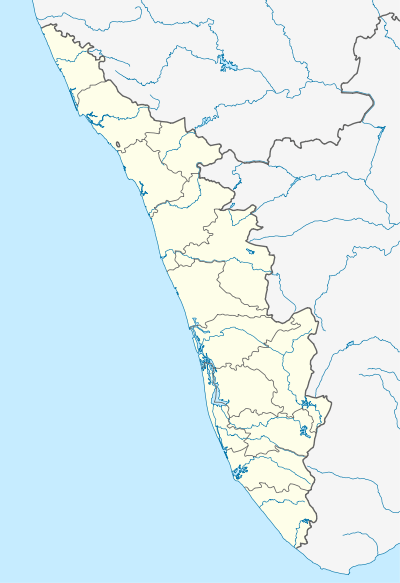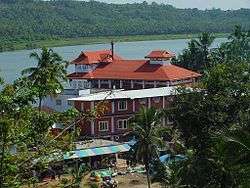Muthappan Temple
| Parassinikadavu Muthappan Temple | |
|---|---|
|
Parassinikadavu Temple | |
 Parassinikadavu Muthappan Temple Location within Kerala | |
| Name | |
| Proper name | Parassinikadavu Madappura |
| Malayalam | പറശ്ശിനിക്കടവ് മഠപ്പുര |
| Geography | |
| Coordinates | 11°58′56.87″N 75°24′7.22″E / 11.9824639°N 75.4020056°ECoordinates: 11°58′56.87″N 75°24′7.22″E / 11.9824639°N 75.4020056°E |
| Country | India |
| State | Kerala |
| District | Kannur district |
| Culture | |
| Primary deity | Muthappan |
| Architecture | |
| Architectural styles | Kerala Kavu Architecture |
| History and governance | |
| Temple board | Malabar Devaswom Board[1] |
Muthappan Temple, also called Parassinikadavu Muthappan temple is a Hindu temple, located at Anthoor Municipality on the banks of the Valapattanam river about 10 km from Taliparamba and 16 km from Kannur Corporation in Kannur District, Kerala.[2][3] Principal deity of the temple is Sree Muthappan, a manifestation of two mythical characters called Thiruvappana and Vellattam. According to the local tradition the presiding deity is a folk deity and not a vedic deity, but there are recent attempts to associate the deity to Vishnu or Shiva.[4]
Rituals of the temple is unique in that it does not follow the Satvic Brahminical form of worship, as in other Hindu temples of Kerala. The main mode of worship is the a ritual enactment of both the characters of Muthappan, through a traditional dance known as Muthappan Theyyam.[4][5] Fish, meat and toddy are the customary offerings to Muthappan.[6] Muthappan Thiruvoppana Mahothsavam is the major festival of the temple, celebrated for three days every year on 19, 20 and 21 of Kumbham (the days correspond to 3, 4 and 5 March).
The legends of Muthappan


A version of the legend of Ponnu Muthappan is narrated here: Naduvazhi of Ayyankara Brahmin family in Payyavoor village and his wife, Padikutty Antharjanam, had no offsprings. Padikutty Antharjanam was an ardent devotee of Shiva and when she found a baby floating in a basket of flowers in the river water when she was coming back after a bath in the river, she took it as the blessing of Lord Shiva, and so was her husband. The child grew up and in his boyhood, he was always for the benefit of downtrodden and poor people. However, to the agony of his family he practiced hunting, and also started eating flesh, which was not allowed for a Brahmin. Unable to bear the indictments from his family, the boy decided to leave home. When his mother attempted to stop him, he looked at her in fury and appeared in his original godly figure before the parent. She bowed down before her son. Nonetheless, she requested him to cover his eyes with a Poikannu, a type of shield for the eyes, since she was afraid that such a fiery look on another occasion may cause to emanate the cosmic force, Shakti, that could change the entire world. Wearing a shield on his eyes, he left the family, and passed through various villages in Malabar, such as Kunnathurpadi, Puralimala, Padavil, Thillenkeri, Kannapuram, Parassinikadavu and Valluvankadav.[5][7]
The legend relates Muthappan with a tribal family for the divine boy started being called as "Muthappan". Accordingly, when he reached a village called Kunnathurpadi, he got a tribalman, Chantan as his friend. One day, when he saw Chantan tapping toddy from Palm tree the boy asked for it but was denied. All of sudden, Chantan was cursed and became a stone. His wife prayed and offered to perform the rituals, Oottu, Tiruvappana and Amruthakalasam, to propitiate the boy in the month of Dhanu. The boy relented and gave her husband back. The Chantan family started to conduct pooja to propitiate the boy and they called him in the name: "Muthappan".
However, according to another version of the legend Muthappan climbed the coconut tree and emptied the toddy jar in the absence of Chantan. When Chantan returned and saw Muthappan holding the jar, he was provoked and defied the latter. It was at this instant, Chantan was cursed.[7]
The chieftain of a nearby village, Kunnathurpadi, who belonged to Karakattidam family, came to know this incident and invited Muthappan to his family. Hence the people of Kunnathurpadi village also started performing rituals to propitiate Muthappan.
The legend also describes a dog which always followed Muthappan throughout his journey. Hence, in the temple of Muthappan, dogs are considered divine and the temple entrance has an idol of dog, at both sides.[5]
Another version of the legend characterizes Sree muthappan as the son of a Thiyya women, Paadikkutty, and hence the people of Thiyya caste consider Muthappan as their principal deity.[8]
Muthappan temples in other locations
Several Muthappan Temples may be found in Kannur and Kasaragod districts,and also in Coorgdistrict of Karnataka state indicating how popular the deity is in this area. Each madappura has its own tradition. There is an interesting story of how Sree Muthappan Temple came to be built. An elder member of the Koroth family (a famous scholar who was known as "Ezhuthachan" for his commendable achievement as a teacher) regularly visited the place now known as the Muthappan temple and drank madhu, a type of liquor. As he was a devotee, before drinking the madhu he would pour some drops of it on the nearby jackfruit tree for an offering. He regularly repeated the practice. Several years after his death, the villagers began having serious problems , so they tried to determine the cause of their woes with the assistance of an astrologer. He determined that, as a result of the old man's offerings, the deity had taken up residence there. After the man's death, Muthappan didn't get any more madhu. His anger was creating the disturbances. To appease him, the villagers erected a temple in his honor. The Koroth family got the right of Koymma (patronage) for the temple.
In modern times, a committee was formed to promote the temple. As a result, it is now visited daily by hundreds of people. They believe that the deity can cure all diseases and bring prosperity to his devotees. There is a Sri Muthappan temple in Mangalore, near Ullal.
Rituals and festivals
The ritualistic enactment of both the characters of Sree Muthappan, Thiruvappana and Vellattam, is performed daily in the early morning and in the evening. Puthari Thiruvappana festival, conducted on 16 Vrichikam (this Malayalam day corresponds to 1 or 2 December), is the first Thiruvappana of the temple year. It is associated with the harvesting season of the region. The last Thiruvappana of the temple year is on 30 Kanni every year.[9]
- Thiruvappana is not performed on the following days:
- 1. Thulam 1st to Vrischikam 15th every year.
- 2. Amaavasi (new moon) day of Karkkitakam and Thulam.
- 3. "Nira" day of the temple.
- 4. When there is a death in the Madappura family.
Popular Offerings
The traditional offerings made to Sree Muthappan by devotees are Paimkutty, Vellattam and Thiruvappana. The offerings to the prime priest, Matayan, are Vecheringat (a boiled mixture of banana, pepper, turmeric powder and salt), Neerkari (a mixture of raw rice powder, salt, turmeric powder and pepper), boiled gram, or coconut slices.[10] Toddy and burnt dry fish are also used as offerings.
Dogs and puppies are no longer accepted as offerings to the Parsinnikadavu temple contrary to popular belief. Might be due to health risks. There are only a few dogs at the temple, who are being taken care by the temple authorities. Other dogs who enter the temple are being chased away by the temple dogs.
Transport
Parassinikadavu is at 22 km from Kannur town. Kannur municipal bus stand is the major bus terminal nearest to the temple.[11]
- Nearest railway station : Kannur, about 16 km
- Nearest airport : Karipur International Airport, Kozhikode, about 110 km from Kannur.
See also
- Anthoor
- Lokanarkavu Temple
- Sree Muthappan
- Parassinikkadavu
- Rajarajeshwara Temple
- Kannur
- Kunnathoor Padi
- Valluvan Kadav Sree Muthappan Temple
- Sree Muthappan Temple Nileshwar
- Temples of Kerala
- Muthappan madappura- Coimbatore
Photo gallery


- The main attraction
- The Cradle
- The entrance
- Inside the park
 Parassinikkadavu Bridge.
Parassinikkadavu Bridge. A view of Valapattanam river from Parassinikkadavu Bridge.
A view of Valapattanam river from Parassinikkadavu Bridge.

References
- ↑ "Temples under Malabar Devaswam Board, Division : Thalassery" (PDF). Malabar Devaswam Board. Retrieved 10 August 2013.
- ↑ A. Sreedhara Menon (1982). The Legacy of Kerala. Department of Public Relations, Government of Kerala. pp. 25–. ISBN 978-81-264-2157-2. Retrieved 25 August 2012.
- ↑ Official website of Kannur
- 1 2 "Muthappan festival". The Hindu. January 24, 2012. Retrieved August 27, 2012.
- 1 2 3 "About Muthappan". Railway Muthappan. Retrieved August 27, 2012.
- ↑ A Sreedhara Menon (2008). Cultural Heritage of Kerala. D C Books. p. 42. ISBN 978-81-264-1903-6. Retrieved 25 August 2012.
- 1 2 "Muthappan". Global Openness Community. Retrieved August 25, 2012.
- ↑ "Muthappan Theyyam". Theyyam.org. Retrieved August 25, 2012.
- ↑ "Rituals". Temple website. Retrieved August 27, 2012.
- ↑ "Rituals". railway Muthappan. Retrieved August 27, 2012.
- ↑ How to reach
External links
| Wikimedia Commons has media related to Muthappan Temple. |
